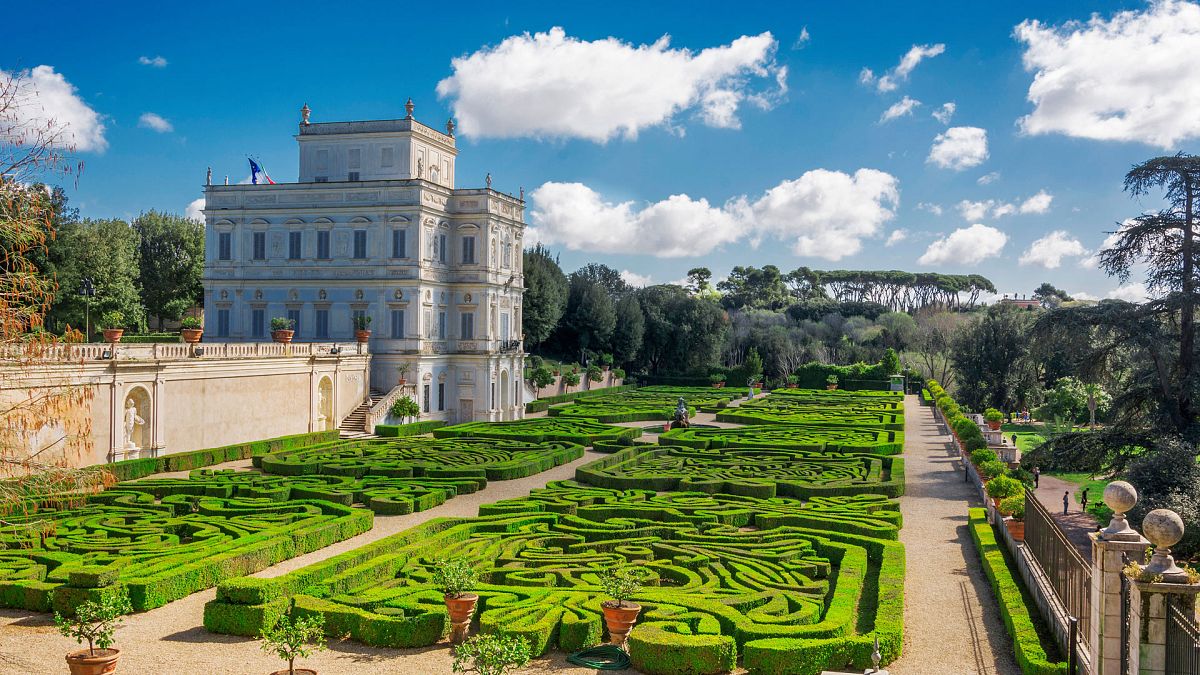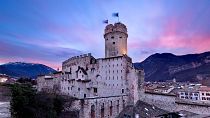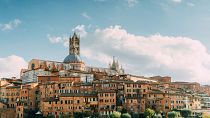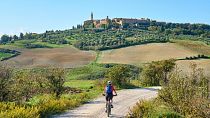Rome may be famed for its ancient ruins and Renaissance art, but it is also Europe’s greenest capital, home to the more green space than any other European city.
Scattered among Rome’s iconic landmarks lies a collection of lush parks, hidden gardens and sprawling heritage villas awaiting your discovery. While Rome’s piazzas throng with vibrant cultural celebrations for the 2025 Jubilee, Rome’s parks promise moments of tranquillity.
Whether you’re picnicking beneath pines, cycling along ancient roads or seeking panoramic city views, Rome’s green spaces offer a quieter, more contemplative side of the Eternal City, perfect for those looking to experience the Jubilee in a more serene setting.
Villa Borghese: art, gardens and panoramic views
Villa Borghese is a quintessential Rome park, offering a mix of manicured gardens, cultural landmarks and shaded paths perfect for a leisurely stroll or bike ride. At its heart lies the Galleria Borghese, an art museum packed full of Renaissance masterpieces, though the park’s open-air art is equally impressive. Take a walk to uncover statues, fountains and even a replica of Shakespeare’s Globe Theatre which hosts open-air performances all summer.
The Pincio Terrace, one of the park’s highlights, offers panoramic views over Piazza del Popolo and the city skyline. For a more serene experience, rent a rowboat on the park’s lake and float leisurely over to the Temple of Aesculapius, an 18th-century masterpiece which rises from the water like a scene from mythology. Nearby, the Bioparco di Roma, the city’s zoo, provides a family-friendly addition to the park’s offerings.
Villa Torlonia: palms, pines and princely history
A smaller, lesser-known alternative to Villa Borghese is Villa Torlonia, a historic 19th century villa once belonging to Prince Giovanni Torlonia before serving as the official residence of Mussolini. Its grounds are dotted with elegant fountains, tree-lined paths and unique structures, including the whimsical Casina delle Civette (House of the Owls). After strolling the gardens, be sure to visit the Villa’s very own museums, for more insight into its fascinating history and the art collection of the Torlonia family.
Between the two villas, the Gardens of Sallust offer an interim moment of calm, featuring a crumbling Roman estate and urban gardens that once belonged to Julius Caesar.
Villa Ada: a sprawling northerly retreat
On the green northern edge of the city lies Villa Ada. Set upon 450 hectares of parkland, Villa Ada is the second largest of Rome’s parks and a favourite among locals and visitors.
As well as the River Tiber running a picturesque trail through the park, this expansive natural haven features wooded areas, open meadows and a serene lake, setting a peaceful scene for outdoor activities like jogging, cycling and picnicking.
Also in the neighbourhood are Parco Virgiliano and Villa Chigi, the latter being the former villa of cardinal Flavio Chigi. These compact but enchanting spots are perfect for brief interludes in nature, underscored by heritage.
Villa Doria Pamphilj: Rome’s largest park
Set upon the expansive 17th-century estate of the Pamphilj family, Villa Doria Pamphilj is Rome’s largest public park and a haven for walkers, joggers and picnickers.
Villa Doria Pamphilj stretches out in style across 184 hectares, with shaded trails weaving through cypress groves, open meadows and tranquil lakes. The park’s vastness makes it ideal for cycling, with both paved and dirt trails that wind through its quieter corners. Locals often gather here for yoga, outdoor workouts or simply to relax beneath the shade of umbrella pines.
At the park’s centre, an avenue of ancient Roman statues points the way towards a stunning Baroque villa known as Bel Respiro, featuring an elevated lookout over lush formal gardens, fountains and more sculptures.
Staying west of the river gives us ample time to tour the lively streets of Trastevere before visiting Villa Sciarra, a more modest green space rich in romance and history.
Formerly the private garden of an aristocratic estate, Villa Sciarra was donated to the city in the early 20th century and was once believed to be a sanctuary dedicated to nymphs. The park still enchants visitors today, with cherubs adorning its fountains and exotic flora and animal-shaped topiaries lining its winding paths, creating a magical setting for a leisurely stroll.
Parco degli Acquedotti: secluded spots along the Appian Way
Few places in Rome combine nature and history as seamlessly as the Appian Way (Via Appian Antica). This ancient Roman road, built in 312 BC, stretches 16 kilometres across and beyond the city, flanked by cypress trees and crumbling archaeological artefacts. The road sits within 3,500 hectares of land, with key attractions including the Caffarella Valley, Via Latina archaeological tombs and Parco degli Acquedotti, the site of several ancient aqueducts.
Visit Parco degli Acquedotti for impressive closeups of the crumbling aqueducts, learning of the ancient technologies that helped Rome thrive, before capturing a perfect sunset.
The Appian Way is best explored by bike, with rental shops offering sturdy bicycles for the cobbled terrain. Stop at landmarks like the Tomb of Cecilia Metella and the Catacombs of San Sebastiano, or simply enjoy the pastoral landscapes that feel untouched by time.
Caffarella Park: pastoral charm in the city
Located just south of the city centre, Caffarella Park feels like a slice of countryside within Rome. Its open meadows, grazing sheep and Roman ruins create a tranquil atmosphere that contrasts with the city’s busier parks. Highlights include the Tomb of Annia Regilla and the mythological Nymphaeum of Egeria, where ancient Romans once gathered for rituals and relaxation.
This park is perfect for families, with plenty of space for picnics and nature walks. Its connection to the Appian Way also makes it a scenic addition to a historical cycling tour.
Orange Garden: a secret oasis on Aventine Hill
The Giardino degli Aranci (Orange Garden) is a compact, fragrant retreat perched on Aventine Hill. Known for its orderly rows of orange trees and peaceful atmosphere, this garden also looks out on one of the most iconic views in Rome. From its terrace, visitors can gaze out over the Tiber River, with St Peter’s Basilica perfectly framed in the distance.
A short walk away lies the Knights of Malta Keyhole, a quirky hidden gem where a perfectly aligned view of the Vatican dome surprises those who peer through the tiny opening. Nearby, the Rose Garden of Rome adds another floral escape, with over 1,000 varieties of roses blooming in spring and early summer.
Botanical Garden of Rome: a natural treasure in Trastevere
Tucked on the hills behind Trastevere’s winding streets lies Orto Botanico, a haven for plant enthusiasts. This 12-hectare garden, managed by Sapienza University, features a Japanese garden, tropical greenhouses and cascading waterfalls. Its shaded paths and centuries-old trees provide a peaceful retreat, far removed from Trastevere’s lively piazzas.
From here, you can explore Villa Farnesina’s gardens, where Renaissance beauty meets natural charm, or climb to the top of Gianicolo Hill, where leafy terraces and sweeping views over the city await, particularly stunning at sunset.
Beyond Rome’s most iconic sights lies a secret, more serene side to the city. After bustling visits to the Colosseum and Vatican City, be sure to branch out to the city’s lesser-known green spaces like Caffarella and the Gardens of Sallust for a quiet moment of reflection.
Visit Italia.it for guidance on planning your visit.




